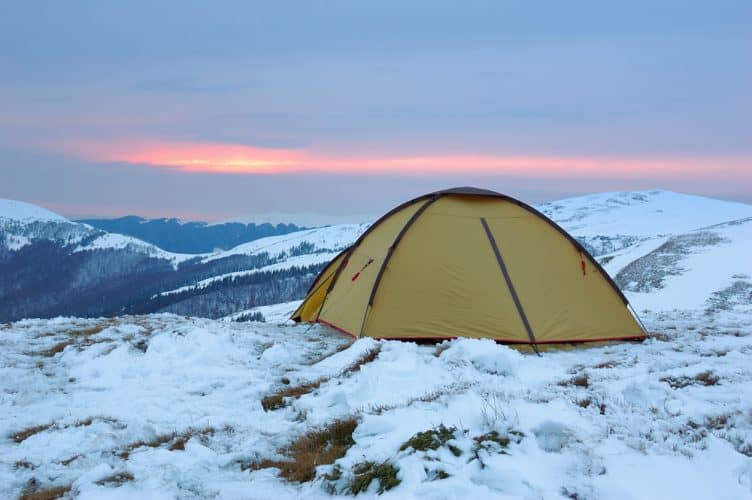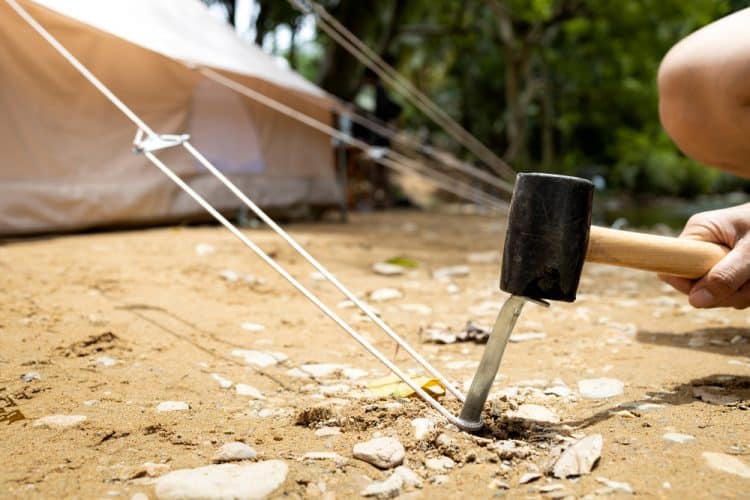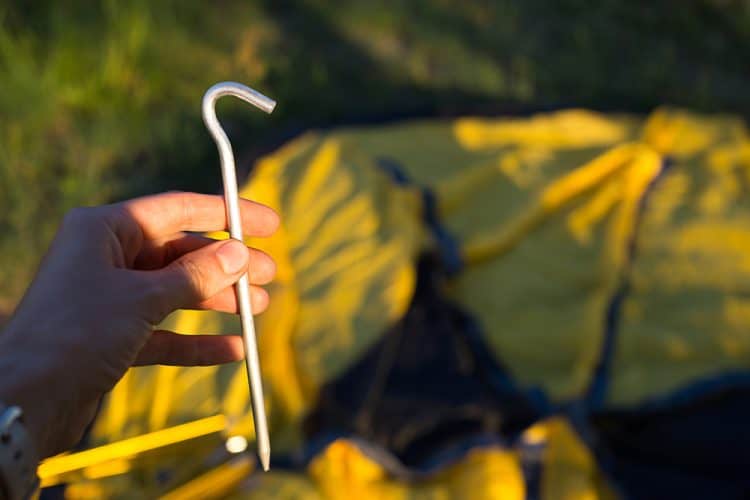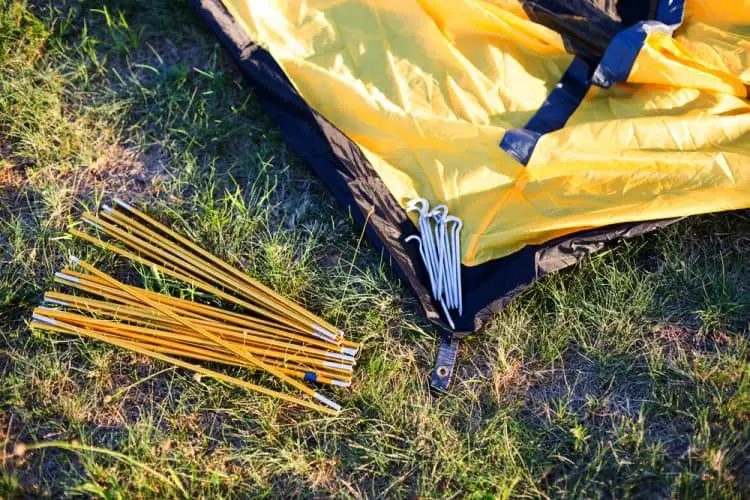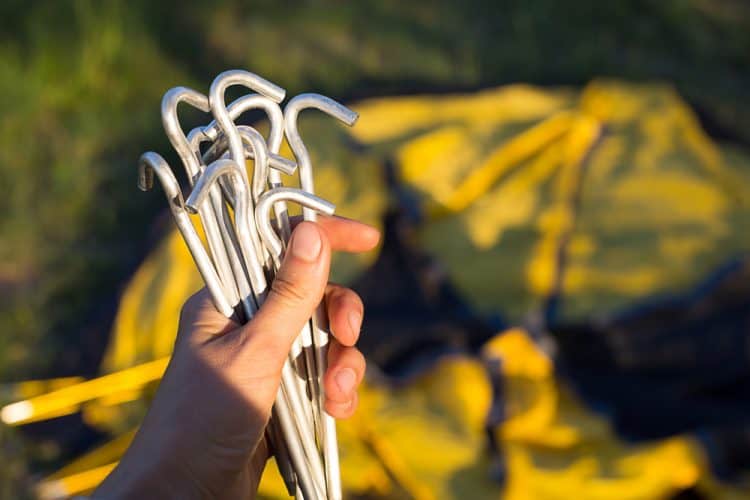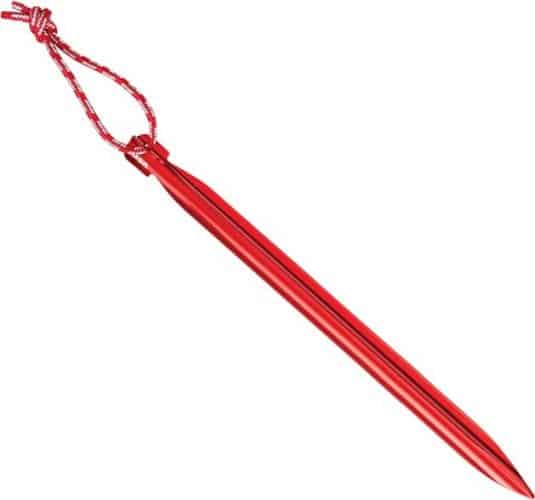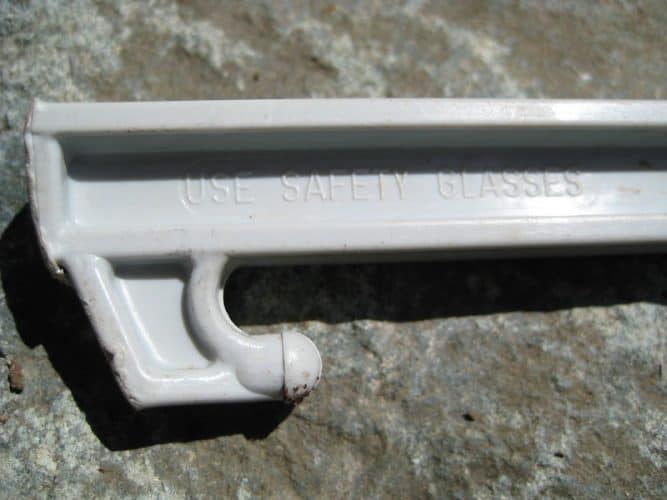How To Use Tent Stakes The Right Way: An Easy Guide [2021]
Love camping?
When you go camping, you have two things that keep your tent attached to the ground: gravity and tent stakes.
Since you have little control over gravity, it is essential to know how to use tent stakes.
Also called tent pegs, the stakes create a physical anchor to the ground that can add structure to your tent and keep it from blowing away.
Anyone who has chased their tent caught by a gust of wind will know how critical this is.
When looking at tent stakes and their use, we will cover camping tents in conditions you are likely to experience during trips in four seasons.
So, if you want to learn from our decades of experience of using stakes and ease your camping life, then continue reading.
Grab a tent stake and let’s begin!
How To Use Tent Stakes The Right Way
The best way to place tent stakes will vary depending on the type of surface you are trying to put them in.
So, let’s see what’s the best way to use tent stakes depending on the soil you’re driving them into.
Soft soil or sand
This is the easiest soil type to push a tent stake into. However, this soil type has the least amount of holding power. Not ideal when you need more holding power.
With soft soil, you can press the stake into the ground by hand. If it is a little too firm for that, then pushing down with your boot will often do it. Place the peg in on an angle roughly 90 degrees from the direction of pull. This will usually mean you are putting the tip angled towards the tent. Doing this will help minimize the risk of it pulling out.
If you are on the sand (spending a night or two after hiking on beach trails, for instance), another technique that can help is to dig down with your hand until you are into a sticky layer that will tend to be denser. Placing your stakes in this layer will generally hold better.
Once the stake is in the ground, compress the dirt around it to increase the holding power. The more holding power, the better.
If you are car camping, consider carrying screw-in pegs, as they will hold the best in sandy soil.
You want to use a peg with the most surface area, like a v-blade or tri-blade, but if you are stuck using thin stakes, consider putting a flat rock on top of the buried peg once you have tied the guy line onto it.
Don't forget that the lines could maximize the interior space of your tent. If used properly, of course.
The extra weight can be enough to keep the anchor buried when your tent is subjected to wind.
Dirt or Grass
It is usually the easiest type of soil to put your stakes in and have them hold. Just push them in either with your hand or foot.
If the ground is firm but lacks rocks, you can pound them gently with a rubber mallet or piece of wood. It won't require much effort.
Avoid using stones to hammer in the pegs if possible, as it can damage the pegs. It sucks to end up with broken stakes. Based on extensive research and testing, I found that a rubber mallet works quite well.
In rare occasions, you can use a flat rock.
Angle the peg perpendicular to the cord you are attaching to it to maximize holding power.
Rocky Ground
When the soil has many rocks in it, then the thinner shepherd's hook or nail-style pegs can be helpful, as they can fit between the stones. The shepherd's hook can be twisted back and forth to find gaps between the rocks.
Due to the stones in the soil, you have fewer options than angles go, but this is less of a concern, as the rocks tend to hold the pegs well.
If the rocks are too large to allow you to insert a tent stake into the ground, you can still use them to help anchor your tent. Tie the guy line to the middle of the peg and weigh it down with a small pile of rocks.
Snow and frozen ground
In winter, how you anchor your tent using your tent stakes (even in the toughest ground) will depend on the depth of the snow.
If you can get to the bare ground, then you will need to use a nail-type peg, as frozen soil is too hard to install any other type easily.
The hardness of the surface will mean that the tent stakes will need to be pounded to get an adequate depth.
You will need a mallet, the back of an ax, or a heavy piece of wood to generate enough force to get the stakes to go in deep enough. Remember not to use your hand or food as this applies uneven pressure.
If you use the shepherd's hook style for this, you will bend them. You can use thin tri-blade pegs in a pinch, but I've had many of them break when being pounded into the frozen ground.
When setting up on deeper snow, you will need to use the snow stakes, as the holding power of snow is even lower than sand.
Like all pegs, you should try to place them on a 90-degree angle to the direction they are being pulled on. Once set, pack down the snow around the stake to increase holding power.
The importance of tent stakes angle
We mentioned it earlier, but you need to pay attention to the angle you set your tent stakes. If you push them straight down on the ground, they will have less holding power than if you get them on an angle.
The shaft of the peg should be angled away from the tent, so the lines are pulling perpendicular and not up. The goal is to have as much dirt as possible resisting the pull of the guy lines.
The same goes when staking out the body of your tent, but since there is less load on these pegs, it is often acceptable to have them pushed straight in.
How to drive tent stakes (And how not to)
When it comes to driving in tent stakes, the technique will vary with the type.
With nail-style, tri-blade, and v-shape, you can tap them in with a mallet or piece of wood. You can use a rock in a pinch, but you are much more likely to damage the peg this way.
With shepherd's hook stakes, they are best put in by hand, either pushing them in or twisting. If you need more force, use the sole of your boot rather than hitting them as they bend easily. If you happen to wear protective boots, the better.
How to remove tent stakes
So far, we've covered how to put tent stakes into the ground, but it is vital to know how to remove them.
Depending on the ground conditions, you can end up with a tent peg that is too hard to pull out by hand.
Because of this, it is recommended to have a loop of strong cords attached to your stakes. Paracord makes a good material for this, as it usually has a 550-pound breaking strength.
Make the loops 3-4 inches long when tied. Many tent stakes have a hole specifically for this.
The cord loop will allow you to put a stick or trekking pole into it, giving you the ability to pull with both hands.
You might need to hit the peg on the top to break it free in frozen ground.
Knots to attach guy lines to tent pegs
Stakes are only part of the equation when it comes to attaching your tent to the ground. You also have to know how to connect your guy lines to the pegs.
Since many tents come with cords with a self-tightening adjuster, you just have to put the loop of cord over the small hook or into the notch on the top of the peg and tighten the line.
If you don't have an adjuster, you need to know how to tie a few knots. The trucker's hitch is a method of cinching the line tight without any hardware.
If your peg doesn't have a small hook or notch, a friction wrap with a half hitch will help keep the cord from coming off the peg.
When putting new guy lines on your tent, the best knot for this is the bowline. It allows you to tie a loop that won't tighten on itself, won't slip loose, and is easy to untie.
How many tent stakes do you need?
The quantity can depend on your tent specifications, but generally, you will need stakes for the tent's corners, vestibule, and guy lines.
For instance, the 2-person MSR Hubba Hubba tent requires ten tent stakes when fully anchored out. That's for maximum holding power.
Depending on the weather, you don't always need to peg out all the anchor points. I often don't attach the guy lines unless the wind is high and gusting.
It is good to add at least one extra tent stake, as it isn't uncommon to break them when pounding them into the ground.
The number of tent stakes you need to secure your tent entirely is larger than most people think, so taking the weight into consideration is essential.
That's also important for staking your tent properly. With that in mind, always bring extra stakes.
That may turn out to be super useful in high winds. And high winds could be quite dangerous sometimes.
For backpacking, aluminum stakes or pegs made of titanium are optimal to keep the weight down and stake down your tent properly. Perfect for anyone who needs to save weight.
The most easily found ultralight tent stake is the MSR Mini-Groundhog. Ten of these pegs only weigh 3.5 oz (100 grams). Excellent for ultralight backpackers. And they have excellent holding power.
In fact, the MSR Ground Hog is our top choice if you need tent stakes for strong winds.
Types of tent stakes
In order to know how to use tent stakes, it’s important to know the different types.
Let's briefly explain them. Note that often, they have different lengths. And the length plays an important role.
Shepard's hook
Shepard's hook tent stakes are just a simple piece of stiff wire with a hook bent at the end. They can be made from aluminum, steel, or titanium.
While light and simple to use, they don't offer the best holding power in soft soil. The hook allows you to twist these pegs into the ground, which can be helpful as the stake can bend easily if pounded.
These stakes are also convenient for suspend a tarp over your tent in order to black it out.
Nail-type
Just as the name implies, the nail-type stakes are shaped like a nail with a straight or spiral shaft. These pegs have a button head to aid pounding in the ground and retaining your guy lines for your tent.

Image via tugawaycuwin.com
They can be made from any metal, but steel is the most common. The advantage is that they are more robust for pounding into the dense or rocky ground.
Due to the lack of surface area, nail-type stakes aren't great at holding when placed into soft surfaces like sand. They don't have those numerous holes that sand pegs have.
Tri-blade
Tri-blade tent pegs are usually made from aluminum and have three lobes that dramatically increase the surface area and stiffness of the shaft. These qualities make them good all-round stakes for multiple types of soil.
The MSR Groundhog and Mini Groundhog are good examples of this type of peg. They are light, hold well, even is softer surfaces, and can be used in mildly rocky soil.
V-blade
V-blade tent stakes are made with a flat piece of metal bent at roughly 90 degrees like a miniature piece of angle iron.
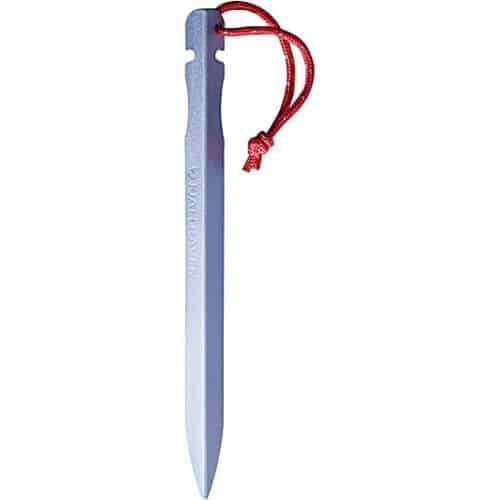
Image via exxpozed.eu
This increases the stiffness and surface area, but not as much as tri-blade stakes.
Plastic
Plastic tent pegs are bright, light, and cheap. They tend to have a lot of surface area, so they hold well on medium to soft soil.
They don't tend to stand up to pounding in, especially in rocky soil.
Screw-in
If you have a large tent (such are recommended for warm weather) or soft conditions, then screw-in tent stakes are a good option.
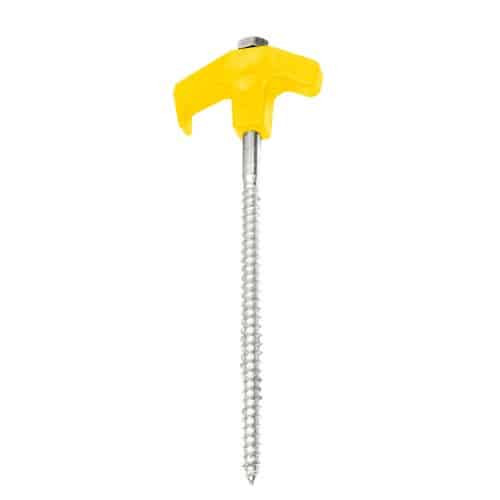
Image via whitesgroup.com
They can take a little more effort to install, but hold well both on an angle and pulled straight out.
They are heavier and bulkier than other pegs, so they are best suited for car camping where you don't have to carry them.
Snow stake
Deep snow is the softest of all surfaces you might set up your tent. You will need much more surface area to anchor your tent guy lines.
Snow stakes are much bigger and have holes, so the snow can fill them in once placed and harden in the cold.
Most snow stakes can also double as sand anchors as long as there are no rocks to get in the way.
Y beam stakes are often used as snow stakes.
Conclusion
Tent stakes are things that no one gets excited about, but will make your day go wrong if you don't have them.
Like any gear, it is crucial to know the right way of using tent stakes effectively to maximize their use and reduce the risk of breaking them.
With the right tent pegs and learning how to use them, you cut down on the chance that a gust of wind will send your tent on a journey of its own.
This is funny to see as long as you aren't the one watching their tent tumble away.
Winston Endall
Having worked in the outdoor, fitness, and cycling industry his whole life, Winston brings a wealth of real world knowledge on the topics. Rock climbing, backpacking, cycling and wilderness survival are his life. As both an athlete, coach, and outdoor educator, his practical experience translates into his writing to help people better pursue their outdoor passions. Read more about Winston here.

![How To Use Tent Stakes The Right Way: An Easy Guide [2021]](https://gearuphiking.com/wp-content/uploads/2021/06/how-to-use-tent-stakes-1.jpg)


